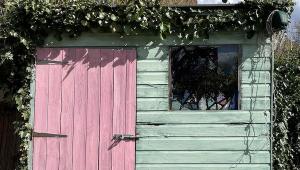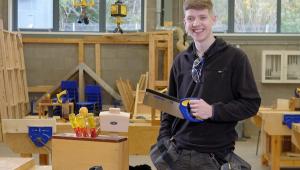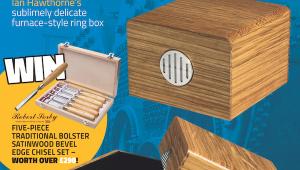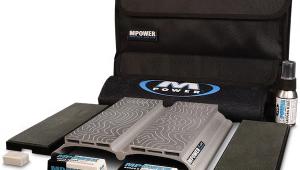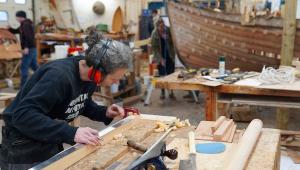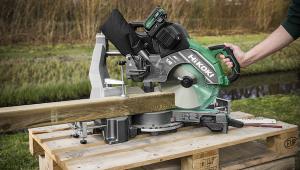The beauty of imperfection
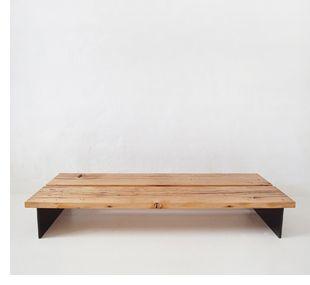
For Glenn Rushbrooke and Samantha Robb – collectively known as Pacha Design – imperfection is more than a quirk of the material with which they work, but something to be actively sought out and embraced; to be celebrated and made a focal point, as opposed to being tamed and controlled. There is a Japanese term for this, they tell us: “Wabi sabi - it’s a view that embraces beauty in imperfection, an appreciation of simplicity and understated elegance and accepting transience. It’s not a design practice, simply a way of thinking. We haven’t incorporated it into our work as such, it’s more that our work is wabi sabi because of our love of imperfect materials and simplicity of design.”
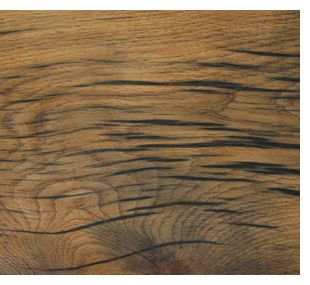 We first met Pacha Design during last year’s Origin craft fair in London (you can read about it here), and were indeed struck by their spare architectural designs that employed unusual non-standardised timber and metal – the very picture of wabi sabi work.
We first met Pacha Design during last year’s Origin craft fair in London (you can read about it here), and were indeed struck by their spare architectural designs that employed unusual non-standardised timber and metal – the very picture of wabi sabi work. “We have always been drawn to simple, pared down design,” they explain, “as our style has developed, we’ve tried to strip away pretence to leave humble and honest design.” They stress, however, that this isn’t as easy as it sounds: “Just because a finished piece looks simple in design doesn’t mean it wasn’t complex to design.”
Of course, it is this hard-won sophisticated minimalism that allows them to bring to the fore the beauty inherent in the imperfect materials they use, which often form the starting point for designs aimed to showcase their unconventional beauty – their rust console table for instance, began with the purchase of some rusty metal plates, simply because Glenn and Samantha thought they were beautiful.
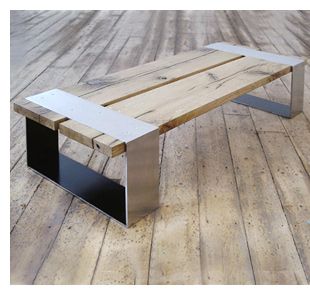 Although this imperfection clearly has great value for its own sake, making each piece unique and eye-catching, it is also closely tied to another important facet of Pacha’s ethos, hinted at by the rusty steel. A great deal of the timber that they use, you see, is reclaimed - from old farmyards, docklands and building sites - as is a lot of the steel. “Before starting our business,” Samantha explains, “Glenn worked in refurbishments for a little while, and the amount of stuff that gets skipped is awful.” Their desire to try to work in a different way tied in with their love of the imperfect, as it goes without saying that the materials they use are far from 'perfect'. “Most furniture makers wouldn’t work with a lot of the reclaimed materials we use – too many imperfections.” These are not a problem for Pacha: “We are inspired by imperfections, whether it’s rust, cracks, weathering or discoloration.” And you can see from the work pictured here that imperfection has truly proved to be stuff of beauty, lending the pieces character and warmth.
Although this imperfection clearly has great value for its own sake, making each piece unique and eye-catching, it is also closely tied to another important facet of Pacha’s ethos, hinted at by the rusty steel. A great deal of the timber that they use, you see, is reclaimed - from old farmyards, docklands and building sites - as is a lot of the steel. “Before starting our business,” Samantha explains, “Glenn worked in refurbishments for a little while, and the amount of stuff that gets skipped is awful.” Their desire to try to work in a different way tied in with their love of the imperfect, as it goes without saying that the materials they use are far from 'perfect'. “Most furniture makers wouldn’t work with a lot of the reclaimed materials we use – too many imperfections.” These are not a problem for Pacha: “We are inspired by imperfections, whether it’s rust, cracks, weathering or discoloration.” And you can see from the work pictured here that imperfection has truly proved to be stuff of beauty, lending the pieces character and warmth. 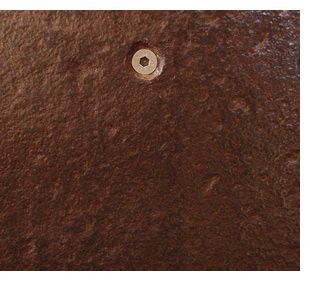 A lot of this character and warmth stems from their use of oak, which dominates their portfolio and seems to particularly lend itself to Pacha’s design ethos. We wondered whether the predominance of oak was by accident or design? “We began making furniture from any reclaimed materials we found – over time, as our style developed, we began to concentrate on mainly using oak, steel and slate. Oak is beautiful, whether new or reclaimed and weathered. It works well with a simple finish that allows it to still breathe and doesn’t change the colour and texture too much, and it’s hardwearing.” We were led to wonder then, how it was that managed to work with some of the more pronounced imperfections – did they require special structural techniques for instance? “We mainly use traditional carpentry methods, mortises and tenons for example, and housing joints,” they answer, “we spend a long time choosing all of our materials, each piece of reclaimed timber, with its knots and cracks, is considered carefully for each piece of furniture.”
A lot of this character and warmth stems from their use of oak, which dominates their portfolio and seems to particularly lend itself to Pacha’s design ethos. We wondered whether the predominance of oak was by accident or design? “We began making furniture from any reclaimed materials we found – over time, as our style developed, we began to concentrate on mainly using oak, steel and slate. Oak is beautiful, whether new or reclaimed and weathered. It works well with a simple finish that allows it to still breathe and doesn’t change the colour and texture too much, and it’s hardwearing.” We were led to wonder then, how it was that managed to work with some of the more pronounced imperfections – did they require special structural techniques for instance? “We mainly use traditional carpentry methods, mortises and tenons for example, and housing joints,” they answer, “we spend a long time choosing all of our materials, each piece of reclaimed timber, with its knots and cracks, is considered carefully for each piece of furniture.” 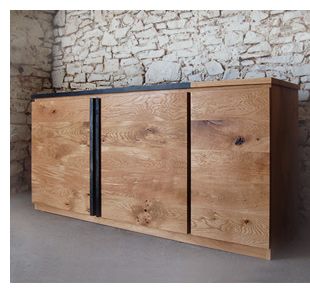 Not all of their timber, it should be noted, is reclaimed, but that of it that isn’t is sourced from local small sawmills that supply timber from local managed woodlands. “Occasionally we’ll used wind fallen timber too, the Cornish slate we use for our furniture (they are based on the border between Cornwall and Devon) is cut for us from our local quarry.” Their commitment to sustainability goes beyond just the materials they use: Glenn and Samantha strive to use non-toxic and solvent free glue, and run their workshop on Good Energy (a power company that provides environmentally friendly electricity). Off-cuts that can’t be put to use are used in their woodburner and waste sawdust is sent to a local potter for raku firing, as well as to the Yarner Trust, an organisation dedicated to sustainable and creative living in north Devon, who use it for composting toilets.
Not all of their timber, it should be noted, is reclaimed, but that of it that isn’t is sourced from local small sawmills that supply timber from local managed woodlands. “Occasionally we’ll used wind fallen timber too, the Cornish slate we use for our furniture (they are based on the border between Cornwall and Devon) is cut for us from our local quarry.” Their commitment to sustainability goes beyond just the materials they use: Glenn and Samantha strive to use non-toxic and solvent free glue, and run their workshop on Good Energy (a power company that provides environmentally friendly electricity). Off-cuts that can’t be put to use are used in their woodburner and waste sawdust is sent to a local potter for raku firing, as well as to the Yarner Trust, an organisation dedicated to sustainable and creative living in north Devon, who use it for composting toilets. Not all woodworkers could adopt Pacha Design’s unique marriage of design and sustainability, but some of these later points could well be considered by those looking to work more sustainably. What advice, we wondered, could they offer to other woodworkers looking to work in a more environmentally friendly manner? “Source timber locally, rather than from Europe and America, so you are supporting small local suppliers and managed woodlands,” is their reponse (FSC certification can help you identify this).
Not all woodworkers could adopt Pacha Design’s unique marriage of design and sustainability, but some of these later points could well be considered by those looking to work more sustainably. What advice, we wondered, could they offer to other woodworkers looking to work in a more environmentally friendly manner? “Source timber locally, rather than from Europe and America, so you are supporting small local suppliers and managed woodlands,” is their reponse (FSC certification can help you identify this). Pacha’s approach to sustainable design is as far away from hair shirt environmentalism as it’s possible to be, and demonstrates perfectly that to work in such a way needn’t be limiting. If anything, it seems massively liberating. So the next time you’re looking at a ‘flawed’ piece of timber, don’t look at what’s wrong with it – take inspiration from Pacha Design, and see the beauty in imperfection.
Glenn and Samantha’s Kaiseki table is featured in the March 2011 issue of Icon magazine. You can see their work Midcentury Modern at Dulwich College on March 20th, at Love Factor: Precious at the Old Glove Factory in Appledore and they will be holding an open studio on 28th April at their workshop near Bideford. More information can be found at Pacha's website.
- Log in or register to post comments
